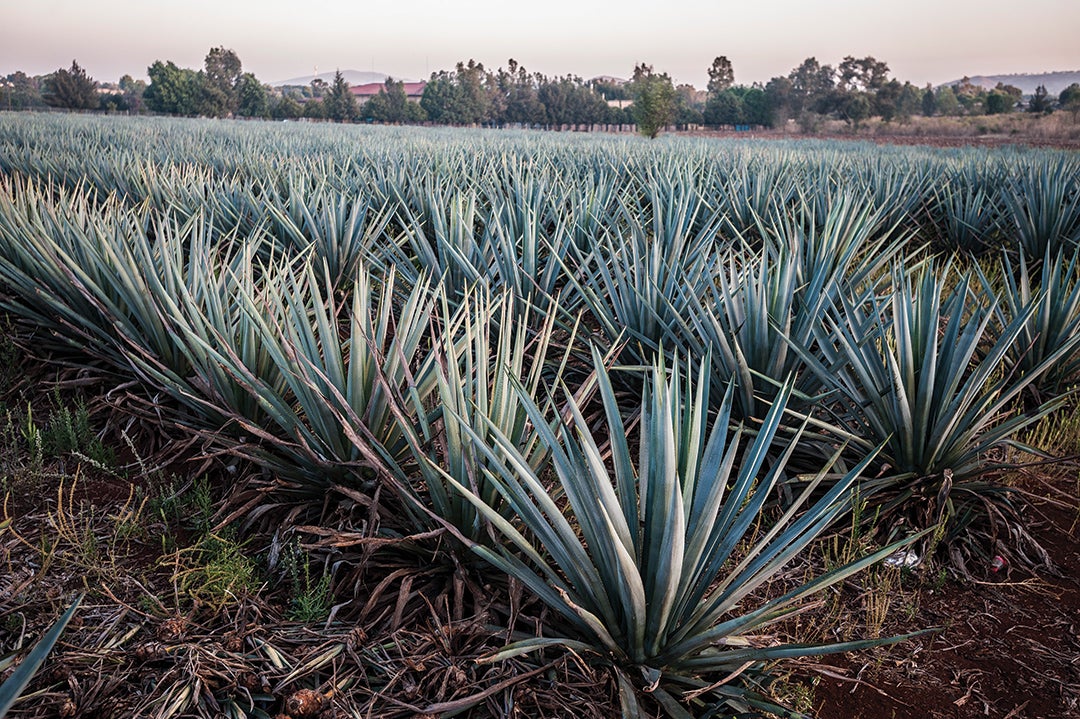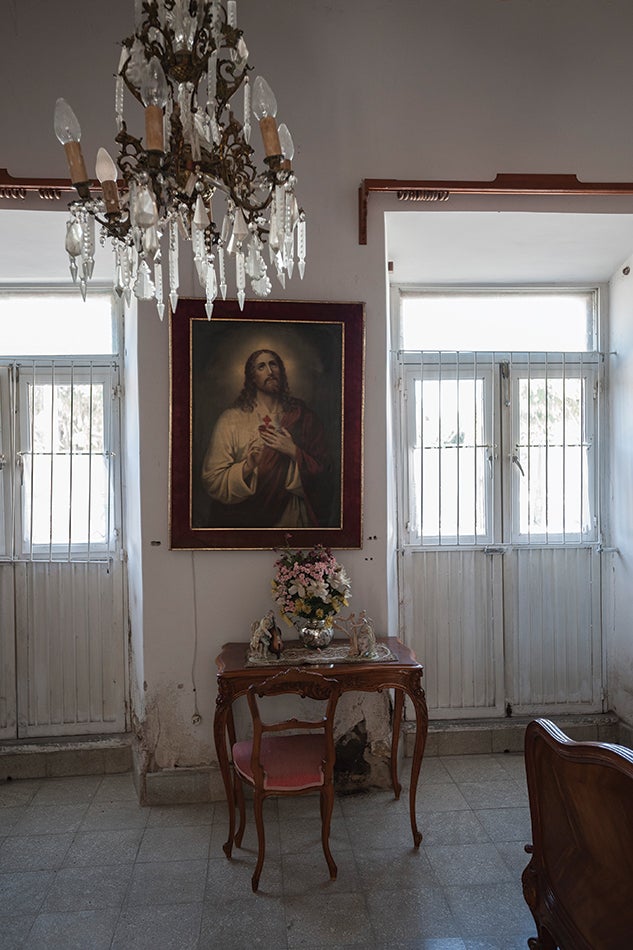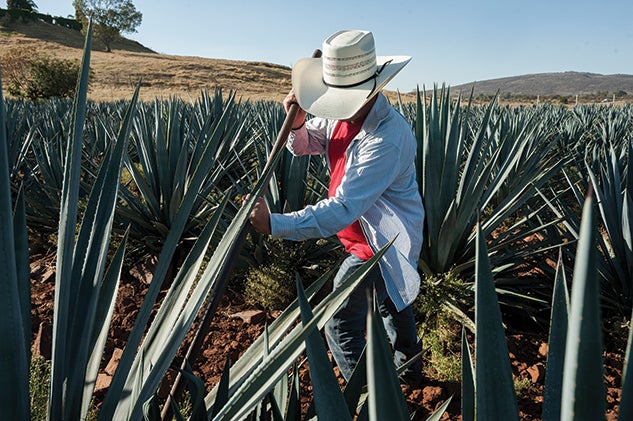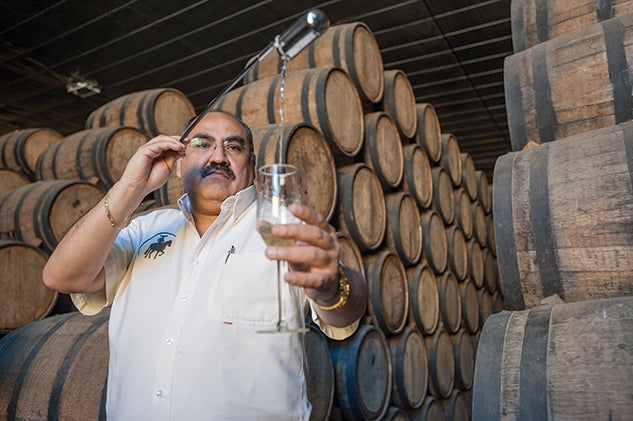The New Agave
Making tequilas and mezcals that are meant to be sipped

By Maya Kroth | Photos by Keith Dannemiller
Family reunions at the Orozco Ranch in rural Mexico gave rise to some of the happiest moments in Iñaki Orozco’s ’05 life. Over the years, childhood afternoons spent splashing in a nearby brook turned into grown-up carousing with aunts, uncles, cousins and second cousins in the small town of La Unión de San Antonio, Jalisco.
“My only complaint was the crappy tequila they were drinking,” Orozco says with a laugh. When he whined about the cheap booze, Orozco’s father told him to shut up and do something about it — assuming, perhaps, that his son would just run down to the corner bodega to pick up a better bottle. He didn’t expect to be presented with a proposal to plant blue agave on the family’s land and eventually make their own tequila.

L



a tank.
ess than a decade later, Riazul Tequila was born, thanks in part to the training Orozco gained at Rice’s Jesse H. Jones Graduate School of Business, where he earned his MBA. Named after that sparkling blue stream where he used to play (río = river, azul = blue), Riazul is Orozco’s attempt at bottling the joy he felt in La Unión, even as he rides out the challenges and uncertainty inherent in the life of an entrepreneur.
Orozco’s first task was to get the blessing of the family patriarch, Uncle Benjamin, to grow agave on the family land. “It’s a pity you inherited the Orozco family good looks and none of the brains,” Benjamin told Iñaki, though he eventually acquiesced. Armed with precisely zero farming experience, Orozco bought 100 blue agave shoots from a friend of his brother’s, said a prayer to the tequila god, put them in the ground and waited. And waited. And waited.
“Agave takes six to seven years to mature,” he explains. There was no guarantee of success, either, especially not at La Unión’s elevation (about 6,300 feet). In the meantime, Orozco arrived in Houston, ready to hone his inborn entrepreneurial spark with real-world business skills.
“Entrepreneurship is more of a spirit than anything else, but it’s important to polish it with education and contact with people who have been successful at it,” he says. “Rice gave me that pathway. It taught me how to start a company, how to value an asset, how to invite external capital sources and how to set up a functional organization.”
By the time the agaves matured, Orozco was in his last semester of business school. The next step was finding a master distiller who would know what to do with the juice. He asked his professor for an extension on his midterms so he could fly to Jalisco and interview tequileros (literally translated as “tequila people”), finding a click with distiller Ruben Morales. Together, they spent the next three years tinkering with the recipe while Orozco juggled a job doing business development for the ATM industry. The goal was to create a tequila that showcased the minerality of the highland soil and the flavor of the plant itself, rather than the cloying sweetness and overpowering alcohol profile of the downmarket brands his family used to drink.
“Tequila has come such a long way,” Orozco says. “High-quality tequilas can go head-to-head with the finest scotches and cognacs.”
By 2008, Orozco was ready to dedicate himself full time to Riazul, which today produces 60,000 liters of tequila per year; about 90 percent of that is sold in the U.S. It’s distributed in 36 states, mostly in bars and restaurants. Last year, as the U.S. continued to see surging demand for Mexican spirits, Riazul added a mezcal to its portfolio.
“Every distillate of agave is a mezcal,” he explains. “Mezcal is the grandfather of everything.” Tequila is made with one specific agave variety — Weber blue — in one specific place (within the tequila’s denomination of origin), but mezcal can be made from several different plants in one of nine Mexican states included in its denomination of origin. The production process differs, too: Tequila distilleries typically operate with industrial efficiency in facilities gleaming with stainless steel equipment such as the autoclaves that steam cook the agave hearts, or piñas, to extract their juice. Mezcal, on the other hand, still uses a 200-year-old artisanal process in which the piñas are cooked in earthen pits underground, lending the spirit its smoky profile.
As a result, there’s more variation in the flavor of mezcal. (Some community rituals even call for hanging a chicken breast or a chunk of iguana meat in the still during distillation, though Orozco’s mezcal doesn’t go quite that far.)
“The sky’s the limit in terms of the profile that you can give a mezcal versus a tequila,” says Orozco, who sells his mezcal under the Riazuleño label, producing about 7,000 liters last year, 95 percent of which was sold stateside.
In entering the saturated premium agave market, Orozco now finds himself competing with the likes of George Clooney, who recently added “tequila tycoon” to his resume. He’s hoping the personal story behind Riazul helps his brand stand out from the pack — though he recently signed his own celebrity spokesman, whose identity he couldn’t yet reveal.
But perhaps the biggest challenge facing his industry is a looming agave shortage, which spurs price fluctuations that have historically pushed small producers like Orozco out of the market altogether.
“If tequila continues to grow at this rate, it might impact everyone,” Orozco explains. “We’ve been cognizant of managing our agave supply with our tequila inventory to ride through the ups and downs that agave goes through. Your best bet is to have your own agave.”
Which, of course, Orozco does, thanks to that fateful decision made so many years ago in La Unión. Not such a silly idea after all, was it, Uncle Benjamin?
